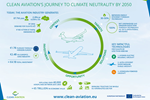Clean Aviation coordinates with EASA, announces 20 new projects
Projects include new wings, integrate fuselage/empennage and H2 storage; collaboration targets evolution of industry standards and new certification methods.
The European Union Aviation Safety Agency (EASA) and the Clean Aviation Joint Undertaking (Clean Aviation, Brussels, Belgium) are enhancing their cooperation to make it more strategic, effective and efficient. According to Patrick Ky, EASA’s executive director, this will build up and consolidate “a resilient and performance-based regulatory framework to effectively support innovation and the EU industry competitiveness while maintaining high safety, security, health and environmental standards.”
Clean Aviation is a leading EU research and innovation program for transforming aviation towards a sustainable and climate-neutral future. EASA and Clean Aviation will cooperate closely in the execution of Clean Aviation’s 20 new projects, officially adopted at the end September 2022. EASA representatives will play an active role in the main Clean Aviation bodies such as its Governing Board, the Technical Committee and the Scientific Advisory Body.
“European aviation is at the forefront of progress towards climate-neutral aviation by 2050. However, to truly lead the way we must set new global standards for safe, reliable, affordable and clean air transport and ensure a regulatory framework that can support an accelerated transformation.” Axel Krein, executive director of Clean Aviation, says. “This collaboration between Clean Aviation and EASA will be an important step in advancing European research and innovation, ensuring a viable path towards market adoption, and bolstering our efforts to achieve this ambitious yet attainable goal.”
The scope of the new activities is laid out in the Memorandum of Cooperation (MOC) signed by the two parties. The cooperation covers aspects such as:
- De-risking and demonstration of the feasibility of the new concepts and technologies implemented under the Clean Aviation program
- Evolution of industry standards
- New certification methods and means of compliance for aircraft and systems designs
- Evolution of the regulatory material in coordination with other regulators and the International Civil Aviation Organization (ICAO).
Another key element of this cooperation will be monitoring the impact of the Clean Aviation Program to ensure its projects meet the environmental targets set to create the pathway towards a climate-neutral aviation system in line with the European Green Deal and EU Climate Law.
Organizing knowledge sharing and dissemination events, in particular in the field of aviation safety, security, environmental protection and promoting the newly setup regulatory framework is yet another facet of the MOC.
Related Content
-
PEEK vs. PEKK vs. PAEK and continuous compression molding
Suppliers of thermoplastics and carbon fiber chime in regarding PEEK vs. PEKK, and now PAEK, as well as in-situ consolidation — the supply chain for thermoplastic tape composites continues to evolve.
-
Plant tour: Albany Engineered Composites, Rochester, N.H., U.S.
Efficient, high-quality, well-controlled composites manufacturing at volume is the mantra for this 3D weaving specialist.
-
Cryo-compressed hydrogen, the best solution for storage and refueling stations?
Cryomotive’s CRYOGAS solution claims the highest storage density, lowest refueling cost and widest operating range without H2 losses while using one-fifth the carbon fiber required in compressed gas tanks.

















